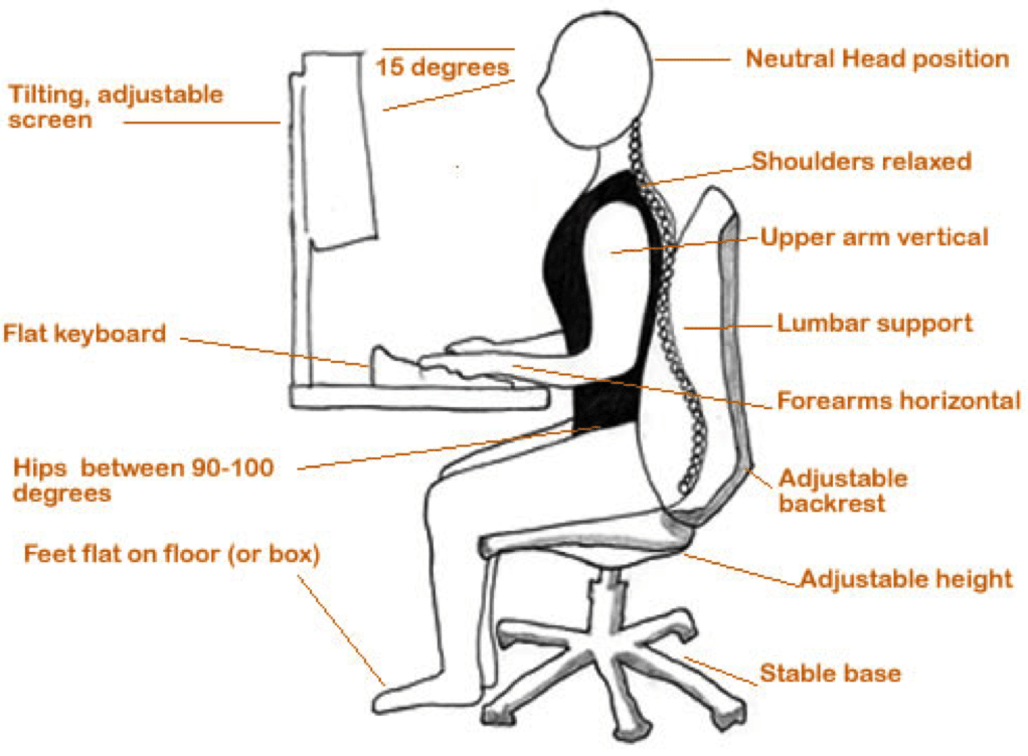What can you do to prevent a repetitive strain injury from too much time sitting at a computer screen – which can create stress on the neck, shoulder, upper and lower back, elbows and wrists.
Repetitive strain injuries from computer work can include damage to the tendons, muscles and nerves, as well as other soft tissues.
What contributes to repetitive strain injuries?
There are a number of factors that can contribute to the onset of a repetitive strain injury from working at a computer. These includE
POSTURE: Posture is the most critical component. Slouching at a desk or keyboard puts your spine and limbs in positions that contribute to increased strain and tension, as well as increasing the risk of eye strain.
OFFICE SETUP: A poorly designed workstation, or one that does not fit you well, can contribute to the onset of repetitive strain injury.
WORK HABITS: Sitting for extended periods of time without changing positions is hard on your whole body and can contribute to the development of a repetitive strain injuries. Other activities, such as pounding the keyboard, using your wrists to move the mouse, or gripping the mouse too tightly, increases the demands on the hand and wrist and can trigger or aggravate symptoms.
What are the early warning signs of a repetitive strain injury?
Early warning signs of a repetitive strain injury can include weakness of your grip, numbness, and discomfort or pain in the arms, hands, wrists or shoulders.
Early diagnosis and treatment are vital to ensure recovery from symptoms.
Use the SMART Principle Guideline to prevent repetitive strain injury.
To decrease your risk you can follow the SMART principle guideline:
STRETCH - Incorporate regular stretching into your work routine. Once every hour try to stretch three or four muscle groups including the hands, shoulders, neck and trunk. Set your screen or phone timer to remind you to take micro-breaks as needed to momentarily change your position throughout the day.
MOVE - Get up from your work station for a short stretch or walk to promote blood flow to fatigued muscles every hour. It could be as simple as a walk around the office or getting off the elevator one floor early and taking the stairs. Move out of the pattern that the work is creating by stretching into the opposite motion.
ADD IT UP - Keep track of activity and build up to 30 minutes of stretching and exercise daily. Vary your tasks (keyboarding, filing, telephone, reading documents etc).

REDUCE STRAIN - Follow these tips to reduce strain:
- Adjust your chair to support your back and minimize awkward postures.
- Avoid slouching.
- Sit with your buttocks right back in the chair and your feet flat on the floor, or on a footrest.
- Bend your knees at a 90 degree angle, at the same level or slightly above your hips.
- Keep your shoulders relaxed with your arms close to your body or resting comfortably on the armrests and elbows bent at approximately 90 degrees.
- Keep your wrists straight.
- Keep your eyes level within range of the top third of the screen, without needing to squint to see the screen.
- Keep your work, keyboard, and mouse centred in front of the monitor to avoid arching your neck or twisting your body.
- Use a good quality mouse that requires minimal pressure to click.
- Use ergonomic computer accessories to encourage neutral neck postures.
- Use headsets to avoid awkward neck postures while using with the computer and telephone.
If you’re working on a computer all day, you may want to limit your computer time at home and integrate activities for leisure and recreation that will not continue to stress the same muscles and tendons.
TALK TO A PHYSIOTHERAPIST - Repetitive strain injuries can be prevented, but if symptoms do occur, early intervention with the assistance of a physiotherapist is the best form of treatment.
Our Physiotherapists Can Help
If you are experiencing regular or increasing discomfort while sitting at your computer, talk to us. One of our experienced physiotherapists will assess you to develop an appropriate treatment plan for the problems you are experiencing now, and a preventative plan for the future.
